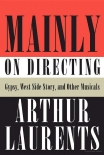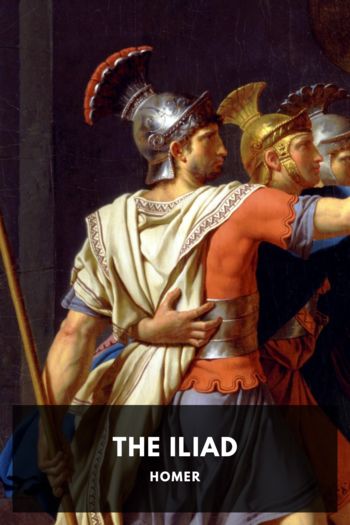Mainly on Directing, Arthur Laurents [best books for students to read TXT] 📗

- Author: Arthur Laurents
Book online «Mainly on Directing, Arthur Laurents [best books for students to read TXT] 📗». Author Arthur Laurents
When I looked at “America,” the big dance number in the first act for Anita and the girls, that phrase “Anita and the girls” expressed exactly what I realized “America” was in West Side Story: a musical comedy would-be show-stopper that had nothing to do with Tony and Maria or the play. West Side's dances were credited with moving the story forward. The dances were brilliant as dances, but “America” interrupted the story, it didn't move the story anywhere anymore than the famous prologue did. That was meant to establish the background for the gang war but what it established first was that the show was driven by dance. All the dances, I gradually realized, had to be examined to see if they really did contribute to the story—my goal was a musical play rather than a danced retelling of a legendary tale. If they didn't contribute, something had to be done to draw them into the play. I began with the prologue.
The opening music is threatening, as set originally and always replicated since; so is the tableau of the Jets on which the curtain rises. Then they start to dance, and in one minute the arms get soft and balletic, the emotions general, threat and gangs are gone, we are into dance-in-blue-jeans and there, by and large, we stay. A sequence meant to show the gang exulting in owning its turf may have looked just that in 1957; in 2008, it looks like musical comedy chorus boys stepping out, as they do in the movie. A Shark knocked to the floor by a Jet spits across the whole stage, his saliva hits the offending Jet on the back of his neck, the Jet turns and leaps on the Shark. That bothered me even in 1957; it had to be replaced with something stronger—a knife. A Jet whacking a Shark with a sack of flour now whacks him with a baseball bat. Even before all that, when the curtain rises, what the audience sees is a very different opening to a very different show.
Only the familiar brief, opening musical figure, as the curtain shoots up on that brutal set. Silence as out of the shadows steps Riff, a Cody Green with a cold, insolent look from hooded eyes. He slowly comes down to the edge of the stage, a Pied Piper for his Jets, who follow like rats down fire escapes, out of holes in a broken tenement, following Riff until they are all at the edge of the stage, glaring at the audience as though to say: “This is ours. Cross the line to come here and we'll cut your balls off.”
The Jets have been set up as potential killers and that's how they dance. When Bernardo and the Sharks arrive to test whether they can cross the line safely, the menace increases and keeps increasing. The Shark no longer spits, he throws a knife across the stage, missing the Jet who now really leaps on the Jet to kill. When A-rab's ear is pierced, the dance moment when all the Sharks turn melodramatically away from A-rab to raise their arms, reaching for God-knows-what, is now all of them raising their fists to beat A-rab to a pulp. The steps are the steps danced over fifty years ago but there is no soft line, only hard angles, and the purpose and the meaning of the steps have been changed by the attitude of the angry, vicious gang members dancing them. The prologue now establishes the brutal world of the story.
“America” was altered more radically, but that change stemmed from a discovery about the lyric. Early in the play, in her first scene with Maria in the bridal shop, Anita's refusal to speak Spanish is set up along with her ability to intimidate other Puerto Ricans into speaking English. This sets up “America” being sung in English— as it has to be for all the jokes to work. The pattern of the song is that Rosalia, who wants to retun to Puerto Rico, sings a verse about something she misses there and is put down by Anita with the tag line. Then Anita sings of what she likes about America and sings the tag line herself.
Seeking a way to make “America” more than a number and pull it into the play, I examined the lyric and immediately saw something that had made sense when “America” was just a dance number. No, as a song in a play, it contradicted itself. If Anita really liked America, as she sang in each verse, why did she end the verse knocking America? Her first verse, for example, praises “everything free in America” but then adds “for a small fee in America.” When I asked Steve Sondheim what he intended Anita's attitude to be when she sang this contradiction, his half-laughing, half-embarrassed answer exemplified what can happen in musicals over time when proper attention has not been paid. In rehearsal, “America” had been set by Peter Gennaro for Anita and Bernardo and the Shark boys and girls. Jerry took Bernardo and the boys out of the number. The tag lines like “for a small fee in America” had been Bernardo's retort to Anita. They were simply transferred to Anita and since Chita's dancing was the purpose of the number, she wasn't singing as a character. A joke was a joke and on to higher kicks.
The way to make “America” part of the play was now clear. It was an aspect of the inner conflict among Latinos, a friendly, comic battle between pro-American Anita, supported by her girlfriends, and pro—Puerto Rican Rosalia, supported by one cousin. The song and the dance were now done by people, characters in the play, not by performers in a number. Joey McKneely was adept at saving much of the choreography while at the same time adding enough to





Comments (0)